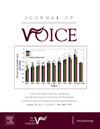荷兰儿童嗓音障碍指数-10 的有效性和可靠性。
IF 2.4
4区 医学
Q1 AUDIOLOGY & SPEECH-LANGUAGE PATHOLOGY
引用次数: 0
摘要
目的:与嗓音相关的生活质量 (Qol) 问卷为临床医生提供了有关嗓音障碍对患者福祉影响的信息。现有的针对荷兰语儿童的嗓音相关生活质量工具都是由父母代理的。然而,文献中对是否使用代理测量方法一直存在争议。儿童嗓音障碍指数-10(CVHI-10)是一种针对发音障碍儿童的自我报告 QoL 工具。因此,本研究旨在开发并验证荷兰版的 CVHI-10:研究设计:观察性、前瞻性、横断面研究:根据生活质量特别兴趣小组--翻译和文化适应小组的建议,将 CVHI-10 的原始版本翻译并改编为荷兰语。随后,77 名 8 至 14 岁的儿童(发音障碍组:n = 30,对照组:n = 47)分别填写了问卷。为了研究测试-再测可靠性,50% 的参与者被要求在两周内完成两次问卷。对问卷的内部一致性、重测信度和建构效度进行了计算。此外,还进行了接收器操作特征(ROC)分析,以检查问卷的灵敏度和特异性水平:用 Cronbach's alpha 系数测量的内部一致性为 0.745。通过类内相关系数测得的重测可靠性为 0.718。发音障碍组的 CVHI-10 平均总分为 6.17 ± 2.7,对照组为 2.68 ± 2.6。组间总分差异具有统计学意义(P < 0.001),表明该工具具有良好的构建效度。ROC 分析表明诊断准确性适中(曲线下面积 = 0.869),并提出了 3.5 分的临界值:荷兰语 CVHI-10 是首个针对荷兰语发音障碍儿童的自我报告嗓音相关 QoL 工具。它是一种有效、可靠和敏感的工具,可用于评估嗓音障碍对儿童健康的影响。本文章由计算机程序翻译,如有差异,请以英文原文为准。
Validity and Reliability of the Dutch Children's Voice Handicap Index-10
Objectives
Voice-related quality of life (Qol) questionnaires provide the clinician with information regarding the impact of voice disorders on the patient's well-being. The available voice-related QoL tools for Dutch-speaking children are parent-proxy in nature. However, the use of proxy measurements has been debated in the literature. The Children's Voice Handicap Index-10 (CVHI-10) is a self-reported QoL tool for dysphonic children. Therefore, the aim of this study is to develop and validate a Dutch version of the CVHI-10.
Study design
Observational, prospective, cross-sectional study.
Methods
The original version of the CVHI-10 was translated and adapted to Dutch according to the recommendations of the Quality of Life Special Interest Group - Translation and Cultural Adaptation group. Subsequently, the questionnaire was individually completed by 77 children (dysphonic group: n = 30, control group: n = 47) between eight and 14 years. In order to investigate test-retest reliability, 50% of the participants were asked to complete the questionnaire twice with an interval of 2 weeks. Internal consistency, test-retest reliability and construct validity were calculated. A receiver operating characteristic (ROC) analysis was conducted to check the sensitivity and specificity levels of the instrument.
Results
Internal consistency measured with Cronbach's alpha coefficient was 0.745. Test-retest reliability measured with intraclass correlation coefficients was 0.718. Mean total CVHI-10 score was 6.17 ± 2.7 in the dysphonic group and 2.68 ± 2.6 in the control group. The difference in total score between the groups was statistically significant (P < 0.001), suggesting that the tool has good construct validity. ROC analysis demonstrated moderate diagnostic accuracy (area under the curve = 0.869) and suggested a cut-off score of 3.5.
Conclusions
The Dutch CVHI-10 is the first self-reported voice-related QoL tool for dysphonic Dutch-speaking children. It is a valid, reliable and sensitive tool to assess the impact of a voice disorder on the child's well-being.
求助全文
通过发布文献求助,成功后即可免费获取论文全文。
去求助
来源期刊

Journal of Voice
医学-耳鼻喉科学
CiteScore
4.00
自引率
13.60%
发文量
395
审稿时长
59 days
期刊介绍:
The Journal of Voice is widely regarded as the world''s premiere journal for voice medicine and research. This peer-reviewed publication is listed in Index Medicus and is indexed by the Institute for Scientific Information. The journal contains articles written by experts throughout the world on all topics in voice sciences, voice medicine and surgery, and speech-language pathologists'' management of voice-related problems. The journal includes clinical articles, clinical research, and laboratory research. Members of the Foundation receive the journal as a benefit of membership.
 求助内容:
求助内容: 应助结果提醒方式:
应助结果提醒方式:


